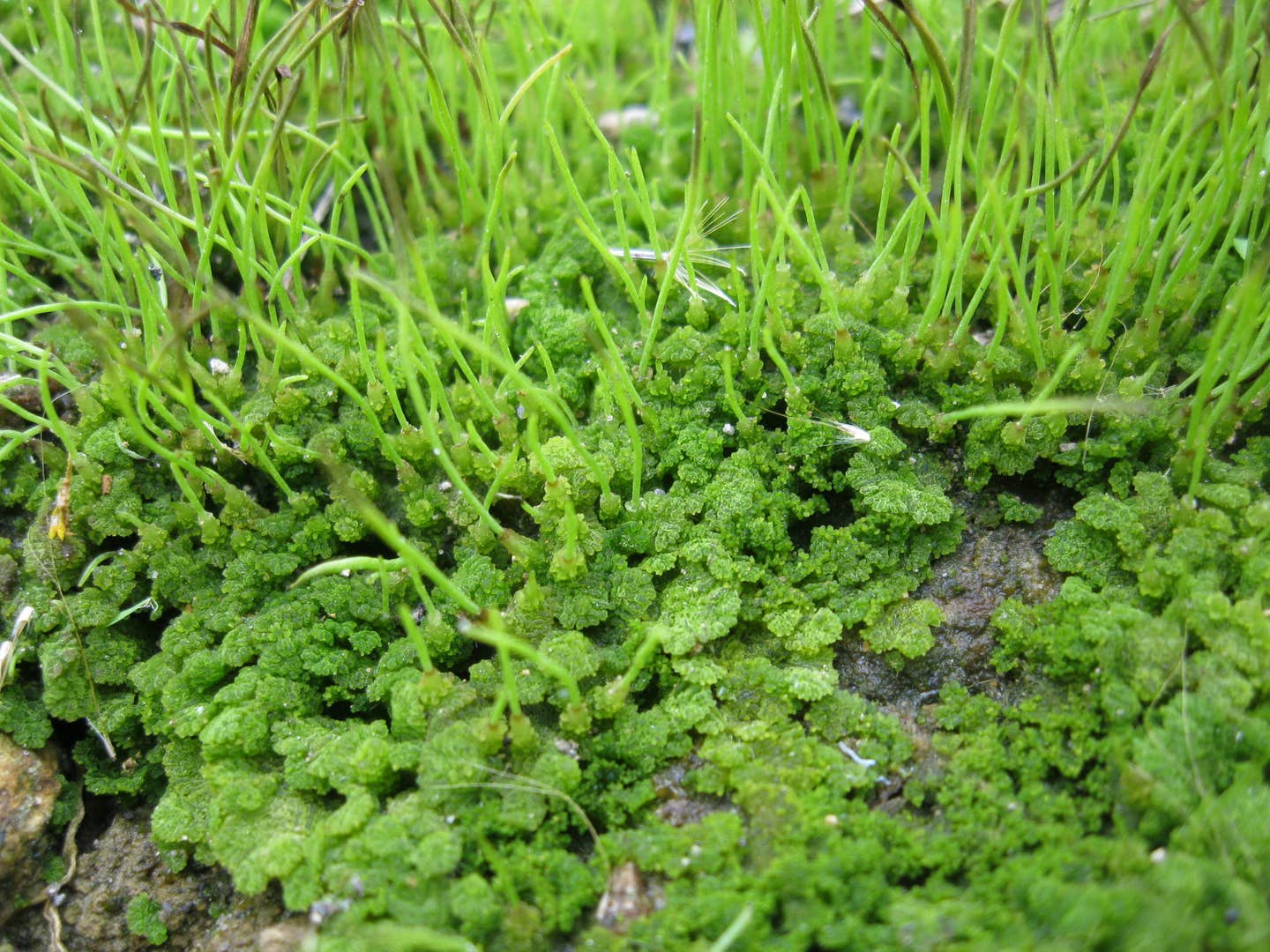This tiny plant could revolutionize agriculture and combat climate change
Discover how hornworts’ CO₂-concentrating mechanisms could boost crop efficiency by 60%, revolutionizing agriculture and combating climate change.

Hornworts possess a unique CO₂-concentrating mechanism that turbocharges photosynthesis, offering new possibilities for agriculture and climate solutions. (CREDIT: CC BY-SA 4.0)
Hornworts, a group of small and often overlooked plants, may hold the key to revolutionizing agriculture and combating climate change. These plants possess a unique biological mechanism that turbocharges photosynthesis, potentially paving the way for more efficient crop growth.
Published in the journal, Nature Plants, recent research into Anthoceros agrestis, an emerging model species of hornwort, sheds light on the remarkable properties of their CO₂-concentrating mechanisms (CCMs) and their potential for agricultural innovation.
Central to hornworts' enhanced photosynthetic ability is a microscopic structure called a pyrenoid. Found within their chloroplasts, pyrenoids act as CO₂ concentration chambers, ensuring that Rubisco—a crucial enzyme in photosynthesis—is saturated with carbon dioxide.
Rubisco, often called the "gatekeeper" of biologically available carbon, captures CO₂ and converts it into sugars. However, this enzyme is notoriously inefficient, frequently reacting with oxygen in a process called photorespiration, which wastes energy and reduces productivity.
Laura Gunn, an assistant professor at Cornell’s School of Integrative Plant Science, explains, “Rubisco is an infamously inefficient enzyme, so most plants waste a lot of energy dealing with its tendency to also react with oxygen. By concentrating CO₂ around Rubisco, hornworts maximize its efficiency and minimize this wasteful ‘photorespiration’ process.”
Unlike algae, which utilize complex systems to pump CO₂ into their cells, hornworts appear to employ a simpler, passive approach. This innovation could offer significant advantages for engineering similar systems into crops. “It’s like finding a simpler, more efficient engine design,” says Fay-Wei Li, associate professor at the Boyce Thompson Institute (BTI) and co-corresponding author of the study.
Pyrenoids in A. agrestis exhibit properties that distinguish them from those in other photosynthetic organisms. Researchers used advanced imaging techniques, such as transmission electron microscopy (TEM) and fluorescence recovery after photobleaching (FRAP), to investigate their structure and physical properties.
Unlike algal pyrenoids, which are encased in a starch sheath to prevent CO₂ leakage, hornwort pyrenoids are surrounded by multiple layers of thylakoids—membranes where photosynthesis occurs. These stacked thylakoids may serve as a diffusion barrier, compensating for the absence of a starch sheath.
Further analysis revealed that hornwort pyrenoids are liquid-like, exhibiting high internal mixing. When the pyrenoids were photobleached, fluorescent markers recovered rapidly, indicating efficient molecular movement within these structures.
Related Stories
This liquid-like property facilitates the distribution of essential proteins, such as Rubisco activase, ensuring the pyrenoid’s functionality during cell division and other cellular processes. During cell division, pyrenoids elongate and are divided between daughter cells, demonstrating their flexibility and adaptability.
The role of thylakoids is another critical aspect of hornwort pyrenoid function. Surrounding the pyrenoid, these membranes house both Photosystem I (PSI) and Photosystem II (PSII), crucial protein complexes that drive the light reactions of photosynthesis.
Researchers discovered that PSI and PSII are tightly associated with the pyrenoid’s membrane, ensuring that the energy captured from sunlight is efficiently utilized to support the carbon-fixing reactions facilitated by Rubisco.
A. agrestis also exhibits a unique organization of photosystems—protein complexes responsible for capturing light energy. Researchers tagged components of Photosystem I (PSI) and Photosystem II (PSII) to examine their localization within chloroplasts.
Both photosystems were found in close proximity to pyrenoids, tightly associated with the surrounding thylakoids. This arrangement likely enhances the efficiency of photosynthesis by streamlining the transfer of energy and CO₂.
Comparative genomic studies revealed that many core components of algal CCMs, including specific transport channels and carbonic anhydrases, are conserved in hornworts. However, hornworts lack an analogue of EPYC1, a protein essential for Rubisco condensation in algae.
Instead, they appear to employ alternative strategies, highlighting their evolutionary ingenuity. Tanner Robison, a graduate student at BTI and first author of the study, noted, “Hornworts possess a remarkable ability that is unique among land plants: they have a natural turbocharger for photosynthesis.”
A deeper dive into the evolutionary history of hornworts reveals that their CCM components likely emerged in the common ancestor of land plants. While other plant lineages lost or modified this feature, hornworts retained and refined it over millions of years. This makes them a valuable model for understanding the evolution of photosynthesis and how biological mechanisms adapt to environmental challenges.
The localization of other proteins in hornwort chloroplasts further underscores their distinct adaptations. For instance, hornworts’ thylakoid membranes lack the precise compartmentalization seen in algal pyrenoids. However, their distribution is optimized to maximize light capture and CO₂ diffusion, offering a simpler yet equally effective design.
The discovery of hornworts' efficient CCMs offers significant implications for agriculture. By mimicking these mechanisms in crops, scientists estimate that photosynthesis efficiency could increase by up to 60%. This improvement could lead to higher yields without requiring additional land or resources, addressing critical challenges in food security.
Moreover, the research underscores the evolutionary importance of these mechanisms. Evidence suggests that the ability to concentrate CO₂ existed in the common ancestor of all land plants. While most plants abandoned this feature over millions of years, hornworts refined it, retaining a system that could now inform sustainable agricultural practices.
“This simplicity could make it easier to engineer similar systems in other plants, like essential crops,” says Li. Such advancements could also play a role in mitigating climate change by enhancing carbon capture and reducing greenhouse gas emissions associated with agriculture.
A critical aspect of this research lies in its potential to create more resilient agricultural systems. Crops equipped with hornwort-like CCMs could better withstand fluctuating CO₂ levels and environmental stressors, ensuring stable yields in diverse conditions. The integration of such systems into staple crops like rice and wheat could transform global food production.
Future research will focus on the biochemical and genetic pathways that support hornwort CCMs. By dissecting these mechanisms, scientists hope to identify key genes and proteins that can be transferred into crop plants. This process will require advanced genetic engineering techniques, as well as extensive field testing to confirm the efficacy of these innovations under real-world conditions.
As scientists continue to study hornworts and their unique adaptations, these unassuming plants are emerging as models for innovation. With support from organizations like the National Science Foundation and the Triad Foundation, ongoing research aims to unlock the full potential of this natural technology.
The insights gained from A. agrestis set the stage for groundbreaking applications in crop engineering and environmental sustainability.
Note: Materials provided above by The Brighter Side of News. Content may be edited for style and length.
Like these kind of feel good stories? Get The Brighter Side of News' newsletter.
Rebecca Shavit
Science & Technology Journalist | Innovation Storyteller
Based in Los Angeles, Rebecca Shavit is a dedicated science and technology journalist who writes for The Brighter Side of News, an online publication committed to highlighting positive and transformative stories from around the world. With a passion for uncovering groundbreaking discoveries and innovations, she brings to light the scientific advancements shaping a better future. Her reporting spans a wide range of topics, from cutting-edge medical breakthroughs and artificial intelligence to green technology and space exploration. With a keen ability to translate complex concepts into engaging and accessible stories, she makes science and innovation relatable to a broad audience.



